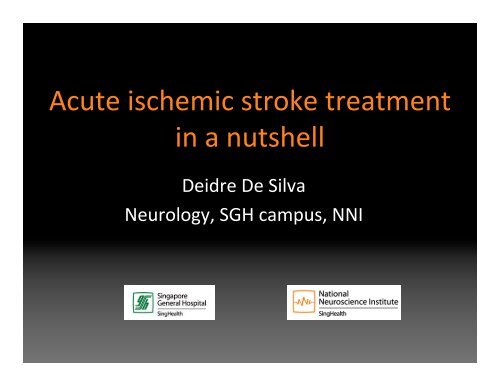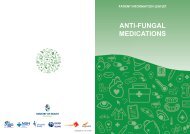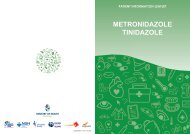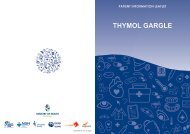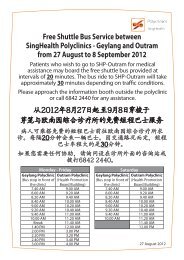Acute ischemic stroke treatment in a nutshell
Acute ischemic stroke treatment in a nutshell
Acute ischemic stroke treatment in a nutshell
- No tags were found...
You also want an ePaper? Increase the reach of your titles
YUMPU automatically turns print PDFs into web optimized ePapers that Google loves.
<strong>Acute</strong> <strong>ischemic</strong> <strong>stroke</strong> <strong>treatment</strong><br />
<strong>in</strong> a <strong>nutshell</strong><br />
Deidre De Silva<br />
Neurology, SGH campus, NNI
<strong>Acute</strong> ischaemic <strong>stroke</strong> <strong>treatment</strong> strategies<br />
Limit damage<br />
from <strong>in</strong>cident<br />
<strong>stroke</strong><br />
Reperfusion<br />
Antithrombotic<br />
BP & glucose control<br />
Prevent and<br />
manage<br />
complications<br />
Stroke Units<br />
Specific<br />
complications
REPERFUSION<br />
TIME IS BRAIN<br />
An estimated 1.2 billion bra<strong>in</strong> cells, <strong>in</strong>clud<strong>in</strong>g 58 million neurons, die for<br />
each hour that an average <strong>stroke</strong> goes untreated. (Jeff Saver, ULCA)
Recanalization of<br />
arterial occlusion
Reperfusion of<br />
salvageable tissue
Attenuation of<br />
Infarct Growth
Improved neurological<br />
& functional outcomes
Reperfusion Strategies<br />
• <strong>Acute</strong> <strong>in</strong>travenous thrombolyis<br />
– Alteplase<br />
– Desmoteplase<br />
– Tenecteplase<br />
• <strong>Acute</strong> <strong>in</strong>tra-arterial thrombolysis<br />
• Mechanical Thrombectomy<br />
• <strong>Acute</strong> angioplasty and stent<strong>in</strong>g
<strong>Acute</strong> <strong>in</strong>travenous alteplase
Specific guidel<strong>in</strong>es
• BENEFIT<br />
RCT EVIDENCE
RCT 3 to 4.5 hours<br />
• ECASS III<br />
• BENEFIT At 3 months, mRS 0-1<br />
– 52.4% tPA, 45.2% Placebo<br />
– OR 1.34 (1.02- 1.76), ARR 7.2%, NNT 14<br />
• RISKS<br />
– sICH 7.9% vs 3.5%, p=0.006<br />
Hacke, NEJM, 2008
TIME IS BRAIN<br />
• At 3 months, OR for good outcome<br />
– 0-90 2.2 (1.8 to 4.5)<br />
– 91-180 1.6 (1.1 to 2.2)<br />
– 181-270 1.4 (1.1 to 1.9)<br />
– 271-360 1.2 (0.9 to 1.5)<br />
Hacke, Lancet 2004
Intravenous thrombolysis (IVT)<br />
• 0-4.5 hours<br />
– Intravenous alteplase 0.9 mg/ kg BW<br />
• Treat as early as possible<br />
• Beyond 4.5 hours<br />
– Consider other <strong>in</strong>travenous thrombolytic agents <strong>in</strong><br />
trial sett<strong>in</strong>g<br />
Eg. DIAS III <strong>in</strong>travenous desmoteplase with<strong>in</strong> 9 hrs
Antithrombotic therapy: Antiplatelet<br />
• Initiation with<strong>in</strong> 48 hours of onset<br />
• AST and CAST studies<br />
• Benefits<br />
– ARR 1% for recurrent <strong>stroke</strong> <strong>in</strong> first 2 weeks<br />
– NNT 83 to prevent death or significant disability<br />
– Low cost, easy adm<strong>in</strong>istration, non toxic<br />
• Mechanism:<br />
– Early secondary prevention<br />
– Possibly penumbral salvage
<strong>Acute</strong> ischaemic <strong>stroke</strong> <strong>treatment</strong> strategies<br />
Limit damage<br />
from <strong>in</strong>cident<br />
<strong>stroke</strong><br />
Reperfusion<br />
Antithrombotic<br />
BP & glucose control<br />
Prevent and<br />
manage<br />
complications<br />
Stroke Units<br />
Specific<br />
complications
Stroke Unit Management<br />
• What is a <strong>stroke</strong> unit<br />
– geographically def<strong>in</strong>ed area<br />
– multidiscipl<strong>in</strong>ary team with tra<strong>in</strong><strong>in</strong>g <strong>in</strong> <strong>stroke</strong> care<br />
• Benefit<br />
– reduces mortality: At 1 yr OR 0.79, NNT 26<br />
– improves functional outcomes: At 1 yr death & dependency<br />
OR 0.82<br />
– advantages extend<strong>in</strong>g to 10 years after <strong>stroke</strong><br />
– benefits replicated outside trial sett<strong>in</strong>g<br />
– cost-effective manner<br />
– applicable to all patients<br />
• Risks: None
How does <strong>stroke</strong> unit management<br />
improve outcome<br />
COMBINATION OF FACTORS <strong>in</strong>clud<strong>in</strong>g:<br />
• screen<strong>in</strong>g for dysphagia<br />
• prophylaxis of deep ve<strong>in</strong> thrombosis and other complications<br />
• lipid profile dur<strong>in</strong>g hospital stay<br />
• diagnosis of pathological mechanism and tailored secondary prevention<br />
• encouragement to stop smok<strong>in</strong>g<br />
• <strong>stroke</strong> education for patients and family<br />
• early coord<strong>in</strong>ated plan<strong>in</strong>g of rehabilitation/discharge (physical, occupational,<br />
speech)<br />
• start of antithrombotic medications with<strong>in</strong> 48 h<br />
• prescription of antithrombotic medication at discharge<br />
• prescription of anticoagulants at discharge<br />
• access to vascular and neurosurgeons
<strong>Acute</strong> ischaemic <strong>stroke</strong> <strong>treatment</strong> strategies<br />
Limit damage<br />
from <strong>in</strong>cident<br />
<strong>stroke</strong><br />
Reperfusion<br />
Antithrombotic<br />
BP & glucose control<br />
Prevent and<br />
manage<br />
complications<br />
Stroke Units<br />
Specific<br />
complications
Anti-thrombotic therapy <strong>in</strong> longterm<br />
secondary <strong>stroke</strong> prevention<br />
Deidre De Silva<br />
Neurology, SGH campus, NNI
Antithrombotic agents<br />
• Antiplatelets<br />
• Anticoagulants<br />
– Hepar<strong>in</strong><br />
• Unfractionated<br />
• LMW<br />
• Hepar<strong>in</strong>oids<br />
– Warfar<strong>in</strong><br />
– Novel agents<br />
• Direct thromb<strong>in</strong> <strong>in</strong>hibitors<br />
• Factor Xa <strong>in</strong>hibitors
Antiplatelets<br />
Dos<strong>in</strong>g<br />
Cost<br />
Side effects<br />
Aspir<strong>in</strong><br />
OM<br />
$0.05 per 100 mg<br />
($0.05 per day)<br />
PUD<br />
Clopidogrel<br />
OM<br />
$1.28 per tab<br />
($1.28 per day)<br />
Ticlopid<strong>in</strong>e<br />
BD<br />
$0.11 per tab<br />
($0.22 per day)<br />
Neutropenia<br />
Dipyridamole<br />
TDS<br />
$0.05 per tab<br />
($0.30 per day)<br />
Headache<br />
Many tablets<br />
Cilostazol<br />
BD<br />
Not available<br />
Headache, palpitations,<br />
dizz<strong>in</strong>ess, diarrhoea
Antiplatelets <strong>in</strong> long-term secondary<br />
<strong>stroke</strong> prevention<br />
Any antiplatelet therapy<br />
Which Antiplatelet<br />
Comb<strong>in</strong>ation
Any antiplatelet therapy<br />
Anti-thrombotic Trialists’ Collaboration<br />
• Antiplatelet therapy among patients with<br />
previous <strong>ischemic</strong> <strong>stroke</strong>/ TIA<br />
– Significantly reduced vascular events<br />
– Over 2 years per 1000 patients,<br />
• 36 fewer serious vascular events<br />
• 25 fewer recurrent <strong>ischemic</strong> <strong>stroke</strong>s<br />
• 6 fewer non-fatal myocardial <strong>in</strong>farction
Which antiplatelet<br />
Acceptable options<br />
Aspir<strong>in</strong> + Dipyridamole<br />
Aspir<strong>in</strong> alone<br />
Clopidogreal alone<br />
Ticlopid<strong>in</strong>e alone
Which antiplatelet better<br />
• Ticlopid<strong>in</strong>e slightly better than aspir<strong>in</strong> post-<strong>stroke</strong> /TIA<br />
(TASS)<br />
– NNT 40 over 39 months for <strong>stroke</strong><br />
– Side effects of ticlopid<strong>in</strong>e<br />
• Clopidogrel may be better than aspir<strong>in</strong> for pts with MI/<br />
Stroke/ PAD (CAPRIE)<br />
– NNT 200 over 23 mths for MI/<strong>ischemic</strong> <strong>stroke</strong>/<br />
vascular death <strong>in</strong> composite group<br />
– No significant difference for <strong>ischemic</strong> <strong>stroke</strong><br />
subgroup
Which antiplatelet better-Comb<strong>in</strong>ations<br />
• Aspir<strong>in</strong> and dipyrimadole better than aspir<strong>in</strong> post-<strong>stroke</strong> (ESPS II,<br />
ESPRIT)<br />
- NNT 104 per year for vascular death, MI, <strong>ischemic</strong> <strong>stroke</strong>, major<br />
bleed<br />
• Aspir<strong>in</strong> and Clopidogrel higher risk than clopidogrel post-<strong>stroke</strong><br />
(MATCH)<br />
– Similar rates for <strong>ischemic</strong> <strong>stroke</strong>/ MI<br />
– Higher rates for ICH/ ,major bleed<strong>in</strong>g<br />
– Not advised for <strong>ischemic</strong> <strong>stroke</strong> <strong>in</strong>dication<br />
– Special situations eg. post coronary <strong>in</strong>tervention<br />
- Aspir<strong>in</strong> + dipyridamole vs clopidogrel post-<strong>stroke</strong> (PROFESS)<br />
- Not superior<br />
- Cannot say if <strong>in</strong>ferior or not
NEW COMERS<br />
Cilostazol<br />
Terutroban
Cilostazol (CSPS II)<br />
• Randomised, double bl<strong>in</strong>d<br />
• Inclusion: cerebral <strong>in</strong>farction with<strong>in</strong> 26 wks<br />
• Cilostazol 100 mg BD vs Aspir<strong>in</strong> 81 mg OM<br />
• Not <strong>in</strong>ferior<br />
• Lower rates of ICH/ major bleed<strong>in</strong>g<br />
At mean of 29 mths<br />
Cilostazol<br />
Aspir<strong>in</strong><br />
RRR<br />
Stroke- <strong>ischemic</strong> or<br />
hemorrhagic<br />
6.1%<br />
8.9%<br />
0.74 (0.56-0.98)<br />
for non-<strong>in</strong>feriority<br />
ICH, other major bleed<strong>in</strong>g<br />
1.7%<br />
4.3%<br />
P=0.004
TERUTROBRAN<br />
(Thromboxane receptor antagonist):<br />
PERFORM study<br />
• Randomized, double-bl<strong>in</strong>d<br />
• Inclusion: recent history of <strong>stroke</strong> or TIA<br />
• Versus aspir<strong>in</strong> or aspir<strong>in</strong> + dipyridamole<br />
• Did not fulfill non-<strong>in</strong>feriority
Anticoagulation <strong>in</strong> long-term<br />
secondary <strong>stroke</strong> prevention<br />
– Cardioembolic <strong>stroke</strong>
Anticoagulants<br />
– Hepar<strong>in</strong>: activates AT III<br />
• UF, LMW, hepar<strong>in</strong>oid<br />
– Warfar<strong>in</strong>: Vit K antagonist<br />
– Direct thromb<strong>in</strong> <strong>in</strong>hibitor: Dabigatran<br />
– Direct Factor Xa <strong>in</strong>hibitor: Rivaroxaban, Apixaban
Anticoagulants<br />
Dos<strong>in</strong>g<br />
Monitor<strong>in</strong>g<br />
SE<br />
UF Hepar<strong>in</strong><br />
6H<br />
PTT<br />
IV<br />
LMW Hepar<strong>in</strong><br />
OM, BD<br />
No need<br />
SC<br />
(Anti-Xa)<br />
Coumad<strong>in</strong><br />
TDS<br />
INR<br />
Variable dose<br />
Interactions<br />
Dabigatran<br />
BD<br />
No need<br />
Just registered by HSA<br />
Rivaroxaban<br />
OM<br />
No need<br />
Not FDA approved yet<br />
Apixaban<br />
BD<br />
No need<br />
Not FDA approved yet
Secondary prevention of <strong>stroke</strong> for<br />
patients with AF
WARFARIN<br />
Secondary prevention: Prior TIA or m<strong>in</strong>or <strong>stroke</strong> (EAFT)<br />
• Warfar<strong>in</strong> (INR 2.5 to 4.0) vs placebo<br />
Effective NNT over 2 y = 6-7<br />
• Aspir<strong>in</strong> 300 mg om vs placebo<br />
Safe alternative NNT over 2 y = 50<br />
• Warfar<strong>in</strong> vs Aspir<strong>in</strong><br />
Warfar<strong>in</strong> superior NNT over 2 y =7-8<br />
At 28<br />
months<br />
Warfar<strong>in</strong><br />
Placebo<br />
P value<br />
Aspir<strong>in</strong><br />
Placebo<br />
P value<br />
Stroke<br />
8.9%<br />
23.4%<br />
NEW COMERS<br />
Dabigatran<br />
Rivaroxaban<br />
Apixaban
DABIGATRAN<br />
AF + high risk for embolism (20% prior <strong>stroke</strong>), RELY: randomised, unbl<strong>in</strong>ded<br />
• Dabigatran 110mg BD vs warfar<strong>in</strong> (INR 2-3)<br />
– Non-<strong>in</strong>ferior for systemic embolisation and <strong>stroke</strong><br />
– Lower major bleed<strong>in</strong>g rates<br />
• Dabigatran 150mg BD vs warfar<strong>in</strong> (INR 2-3)<br />
– Superior for systemic embolisation and <strong>stroke</strong><br />
– Similar major bleed<strong>in</strong>g rates<br />
• ** Higher risk of MI<br />
• ** Renal impairment<br />
At 2 years<br />
Warfar<strong>in</strong><br />
Dabigatran 110<br />
Dabigatran 150<br />
Stroke + systemic embolism<br />
1.69%<br />
1.53%<br />
1.11%<br />
Major bleed<br />
3.36%<br />
2.71%<br />
3.11%<br />
Mortality<br />
4.13%<br />
3.75%<br />
3.64%
DABIGATRAN<br />
• 1000 <strong>stroke</strong> patients treated with dabigatran<br />
over warfar<strong>in</strong> for 1 year<br />
– 150 mg BD: 7 fewer <strong>stroke</strong>s, same bleed<strong>in</strong>g rate<br />
– 110 mg BD: 5 fewer <strong>stroke</strong>s, 14 fewer bleeds
RIVAROXABAN<br />
AF + high risk for embolism (53% prior <strong>stroke</strong>)<br />
ROCKET-AF: randomised, bl<strong>in</strong>ded<br />
• RIVAROXABAN 20 mg OM vs warfar<strong>in</strong> (INR 2-3)<br />
– Per protocol: <strong>stroke</strong> and non-CNS systemic embolism (1.70% vs.<br />
2.15%, p=0.015), 21% relative risk reduction<br />
• Non-<strong>in</strong>terior<br />
• No proof of superiority<br />
– Intent to treat (ITT): (2.12% vs. 2.42%)<br />
• Non-<strong>in</strong>ferior<br />
• Superior<br />
• Any bleed<strong>in</strong>g: No <strong>in</strong>creased risk (14.91% vs. 14.52%, p=0.442)<br />
• Major bleed<strong>in</strong>g: Comparable (3.60% vs. 3.45%, p=0.576)<br />
• ICH: Fewer (0.49% vs. 0.74%, p=0.019)
RIVAROXABAN<br />
• 1000 <strong>stroke</strong> patients treated with rivaroxaban<br />
over warfar<strong>in</strong> for 1 year<br />
– 3 fewer <strong>stroke</strong> and system<strong>in</strong> embolism<br />
– 1 fewer major bleed
APIXABAN<br />
AF patients could not tolerate warfar<strong>in</strong> (14% prior <strong>stroke</strong>) (AVERROES)<br />
• Apixaban 5 mg BD vs Aspir<strong>in</strong><br />
– Stroke and systemic embolism (1.6% vs 3.7% per year)<br />
P
APIXABAN<br />
18 000 AF patients (ARISTOTLE trial)<br />
• Apixaban 5 mg BD VS. Dose adjusted Warfar<strong>in</strong><br />
• Prelim<strong>in</strong>ary results “non<strong>in</strong>ferior to the older<br />
standard for the prevention of <strong>stroke</strong> and<br />
systemic embolism”<br />
• Full results out on August 28
Other <strong>in</strong>dications for anticoagulation<br />
Cardiomyopathy<br />
Post MI<br />
• Anterior wall MI<br />
• Any MI with severe RWMA<br />
LV thrombus<br />
Mitral stenosis with or without AF<br />
Prothrombotic states
Rationalis<strong>in</strong>g long-term therapy
Good Side: Beneficial Effects<br />
• Retard/ reverse acute thrombotic process<br />
• Prevention of recurrent <strong>ischemic</strong> <strong>stroke</strong><br />
• Prevention of other <strong>ischemic</strong> events<br />
– IHD<br />
– PVD<br />
• Prevention of complications eg. DVT
Dark Side: Adverse effects<br />
• Haemorrhage<br />
– Intracranial<br />
– Extracranial<br />
• Allergic/ hypersensitivity<br />
• Upper-GI toxicity (aspir<strong>in</strong>)<br />
• Sk<strong>in</strong> rash (thienopyrid<strong>in</strong>e)<br />
• Diarrheoa (thienopyrid<strong>in</strong>es)<br />
• Neutropenia, thrombocytopenia (Ticlopid<strong>in</strong>e)<br />
• Headache, gidd<strong>in</strong>ess (Dipyridamole: 1/3 discont<strong>in</strong>ue)<br />
• Monitor<strong>in</strong>g (warfar<strong>in</strong>)<br />
• Drug <strong>in</strong>teractions<br />
• Food <strong>in</strong>teractions
One of many concerns<br />
Don’t forget about<br />
• Management of <strong>stroke</strong> complications<br />
• Management of atherosclerotic risk factors<br />
– Hypertension<br />
– Diabetes<br />
– Hyperlipidemia<br />
– Smok<strong>in</strong>g cessation<br />
– Obesity management
Antithrombotic therapy:<br />
Considerations for <strong>in</strong>dividual patient<br />
• Side effects<br />
• Dos<strong>in</strong>g, Compliance, Need for monitor<strong>in</strong>g<br />
• Cost<br />
• Other <strong>in</strong>dications<br />
• Contra-<strong>in</strong>dications<br />
• Resistance<br />
– no guidel<strong>in</strong>es yet, much ongo<strong>in</strong>g research<br />
• Genetic polymorphisms<br />
• Need for gastric protection<br />
• Drug-drug <strong>in</strong>teraction<br />
• Drug-food <strong>in</strong>teraction
Great population benefit <strong>in</strong> view of high<br />
<strong>in</strong>cidence of <strong>stroke</strong><br />
• ESPRIT (A+D vs A) ARR 3% over 3 years<br />
– NNT to prevent vascular event/ bleed<strong>in</strong>g <strong>in</strong> 3 years = 33<br />
• In S<strong>in</strong>gapore, 10000 <strong>ischemic</strong> <strong>stroke</strong> pts/ yr<br />
– Assume 2/3 can be treated with A + D = 6666<br />
– Number of potential events prevented for one year<br />
cohort after 3 years = 202
Thank<br />
you
Management of Hypertension,<br />
Diabetes and Dyslipidemia for<br />
Secondary Stroke Prevention<br />
Jennifer Justice F. Manzano, MD<br />
Stroke Fellow<br />
S<strong>in</strong>gapore General Hospital campus<br />
National Neuroscience Institute
Hypertension<br />
• Hypertension is the most modifiable <strong>stroke</strong> risk factor<br />
• Systolic and diastolic BP are associated with recurrent<br />
<strong>stroke</strong><br />
– But there is no clear threshold<br />
• Should all post-<strong>stroke</strong> patients be given<br />
antihypertensives<br />
• Which antihypertensives to use<br />
• What is the target BP
Should all post-<strong>stroke</strong> patients be given<br />
antihypertensives<br />
• PROGRESS Trial<br />
- Significant reduction <strong>in</strong> recurrent <strong>stroke</strong> only for those<br />
with basel<strong>in</strong>e SBP ≥ 140 mm Hg<br />
PROGRESS Collaborative Group, Lancet 2001
Should all post-<strong>stroke</strong> patients be given<br />
antihypertensives<br />
Mancia, et al, J Hypertens 2009
Should all post-<strong>stroke</strong> patients be given<br />
anti-hypertensives<br />
• No.<br />
– Only start <strong>treatment</strong> if BP >140/90 mmHg<br />
– Not certa<strong>in</strong> for BP 130-140/80-90 mmHg<br />
– Not for BP
Which antihypertensives to use<br />
• Stroke risk reduction correlates with BP reduction<br />
• No drug-class specific <strong>treatment</strong> effect<br />
– Major antihypertensive drug classes do not<br />
differ significantly <strong>in</strong><br />
• BP reduction<br />
• Cardiovascular risk reduction
Which antihypertensives to use<br />
Law, et al, BMJ 2009
Which antihypertensives to use<br />
• Direct data that diuretics or diuretics + ACEI are<br />
useful (AHA/ASA 2010 Guidel<strong>in</strong>es)<br />
• Individualized <strong>treatment</strong><br />
– Each drug class has specific <strong>in</strong>dications,<br />
contra<strong>in</strong>dications, side effects
Which antihypertensive to use<br />
- Comb<strong>in</strong>ation therapy<br />
• Effective BP control is often only achieved by comb<strong>in</strong><strong>in</strong>g<br />
at least 2 antihypertensive drugs<br />
• Comb<strong>in</strong>ation therapy as <strong>in</strong>itial <strong>treatment</strong> may have<br />
advantages, especially <strong>in</strong> high-risk patients <strong>in</strong> which<br />
early BP control is desirable<br />
• CAUTION: Beta blocker + diuretic favors the<br />
development of diabetes <strong>in</strong> predisposed patients
Which antihypertensive to use<br />
- Comb<strong>in</strong>ation therapy<br />
Law, et al, BMJ 2009
Which antihypertensive to use<br />
- Comb<strong>in</strong>ation therapy<br />
Law, et al, BMJ 2009
Which antihypertensive to use<br />
- Comb<strong>in</strong>ation therapy<br />
Law, et al, BMJ 2009
What is the target BP – Upper limit<br />
• JNC 7:
What is the target BP – Upper limit<br />
• AHA/ASA (2010) and European (2009) guidel<strong>in</strong>es:<br />
What is the target BP – Lower limit<br />
J-Curve Phenomenon<br />
• In patients at high<br />
cardiovascular risk,<br />
antihypertensive<br />
<strong>treatment</strong>s that reduce<br />
SBP to ≤ 120-125 mmHg<br />
and DBP < 70-75 mm Hg<br />
may be accompanied by an<br />
<strong>in</strong>crease <strong>in</strong> the <strong>in</strong>cidence of<br />
coronary events<br />
Chrysant, World J Cardiol 2011
What is the target BP – Lower limit<br />
J-Curve Phenomenon<br />
• J-curve phenomenon exists even <strong>in</strong> placebo-treated<br />
groups of many trials<br />
• Between SBP 120-140 mmHg and DBP 70-80 mmHg,<br />
the differences <strong>in</strong> achieved cardiovascular protection are<br />
small<br />
• Lower is not always better!<br />
• No clear guidel<strong>in</strong>es currently
Diabetes<br />
• Diabetes is a risk factor for <strong>stroke</strong>, but its<br />
relationship to recurrent <strong>stroke</strong> is unclear.<br />
• Does good glycemic control translate to<br />
reduction of <strong>stroke</strong> recurrence<br />
• How tight should glycemic control <strong>in</strong><br />
diabetics
Does good glycemic control translate to<br />
reduction of <strong>stroke</strong> recurrence<br />
• DCCT and UKPDS : Good glycemic control<br />
– Reduces microvascular complications<br />
– No reduction <strong>in</strong> macrovascular complications<br />
DCCT Research Group, N Engl J Med, 1993<br />
UKPDS Group, Lancet 1998
Why DM control <strong>in</strong> <strong>stroke</strong> patients<br />
40% of <strong>stroke</strong><br />
patients <strong>in</strong><br />
S<strong>in</strong>gapore<br />
have DM<br />
De Silva, et al, Cerebrovasc Dis 2005
Does good glycemic control translate to<br />
reduction of <strong>stroke</strong> recurrence<br />
• DCCT and UKPDS follow up after the study ceased<br />
11 years<br />
• No significant difference <strong>in</strong> HbA1c<br />
• Significant reduction <strong>in</strong> cardiovascular events <strong>in</strong> those with good<br />
glycemic control previously<br />
DCCT Research Group, N Engl J Med, 1993<br />
UKPDS Group, Lancet 1998
How tight should glycemic control be <strong>in</strong><br />
diabetics - ACCORD Study<br />
10,251 patients with mean HbA1c 8.1% +<br />
Previous cardiovascular event or at least 2 vascular risk<br />
factors<br />
Intensive therapy<br />
(target HbA1c
How tight should glycemic control be <strong>in</strong><br />
diabetics - ACCORD Study<br />
Outcome<br />
Nonfatal<br />
<strong>stroke</strong><br />
Fatal<br />
<strong>stroke</strong><br />
Intensive<br />
therapy<br />
(HbA1c
How tight should glycemic control be <strong>in</strong><br />
diabetics - Other Studies<br />
• ADVANCE and VADT: no significant difference <strong>in</strong><br />
- cardiovascular events<br />
- mortality<br />
Patel, et al, N Engl J Med 2008<br />
Duckworth, et al, N Engl J Med 2009
How tight should glycemic control be <strong>in</strong><br />
diabetics<br />
• Current recommendation: HbA1c
Dyslipidemia<br />
• Modest relationship between high total cholesterol or LDL with<br />
an <strong>in</strong>creased risk of <strong>ischemic</strong> <strong>stroke</strong>.<br />
• L<strong>in</strong>k between high triglycerides and <strong>ischemic</strong> <strong>stroke</strong><br />
• Possible l<strong>in</strong>k between low LDL and ICH.<br />
• Larger reduction <strong>in</strong> LDLc greater <strong>stroke</strong> reduction<br />
– Meta-analysis of stat<strong>in</strong> trials <strong>in</strong>clud<strong>in</strong>g >90,000<br />
patients<br />
• Should all post-<strong>stroke</strong> patients be on stat<strong>in</strong>s<br />
• What is the target lipid level
Should all post-<strong>stroke</strong> patients be on<br />
stat<strong>in</strong>s – SPARCL Trial<br />
• 4371 persons with LDLc 100-190mg/dL<br />
• Prior <strong>stroke</strong> (hemorrhagic or <strong>ischemic</strong>) or TIA, no hx of CAD<br />
• Randomized to 80 mg Atorvastat<strong>in</strong> vs. Placebo<br />
• Mean follow-up of 4.9 years<br />
• Mean LDLc: 73 mg/dL Atorvastat<strong>in</strong> vs. 129 mg/dL<br />
• Endpo<strong>in</strong>t: fatal and nonfatal <strong>stroke</strong><br />
– Atorvastat<strong>in</strong> 11.2% vs Placebo 13.1%<br />
– 5-yr absolute <strong>stroke</strong> risk reduction 2.2%, p=0.03, NNT = 45<br />
– 5-yr absolute risk reduction <strong>in</strong> cardiovascular events 3.5%,<br />
p=0.002, NNT= 29<br />
– hemorrhagic <strong>stroke</strong>s: Atorvastat<strong>in</strong> 55 vs. 33 Placebo<br />
Amarenco, et al, Stroke 2007
Stat<strong>in</strong>s and <strong>ischemic</strong> <strong>stroke</strong><br />
- Meta-analysis<br />
Amarenco, et al, Lancet Neurol 2009
Stat<strong>in</strong>s and hemorrhagic <strong>stroke</strong><br />
- Meta-analysis<br />
Amarenco, et al, Lancet Neurol 2009
Should all <strong>stroke</strong> patients be on stat<strong>in</strong>s<br />
What is the target LDL<br />
Risk Factors<br />
Recommendation - Lipids<br />
Class/Level of<br />
Evidence<br />
Stat<strong>in</strong> therapy with <strong>in</strong>tensive lipid-lower<strong>in</strong>g effects is recommended<br />
to reduce risk of <strong>stroke</strong> and cardiovascular events among patients<br />
with <strong>ischemic</strong> <strong>stroke</strong> or TIA who have evidence of atherosclerosis,<br />
an LDLc level ≥100 mg/dl, and who are without known CHD.<br />
For patients with atherosclerotic <strong>ischemic</strong> <strong>stroke</strong> or TIA and without<br />
known CHD, it is reasonable to target a reduction of at least<br />
50% <strong>in</strong> LDLc or a target LDLc level of
Cr: Ian Sayson
BP control<br />
<strong>in</strong> secondary <strong>stroke</strong> prevention<br />
• Should all post-<strong>stroke</strong> patients be given<br />
antihypertensives<br />
– Only start <strong>treatment</strong> if BP >140/90 mmHg<br />
– Not certa<strong>in</strong> for BP 130-140/80-90 mmHg<br />
– Not for BP
Glycemic control<br />
<strong>in</strong> secondary <strong>stroke</strong> prevention<br />
• Does good glycemic control translate to<br />
reduction of <strong>stroke</strong> recurrence<br />
– No clear reduction <strong>in</strong> macrovascular<br />
complications such as <strong>stroke</strong><br />
• How tight should glycemic control <strong>in</strong> diabetics<br />
HbA1c
Lipid control<br />
<strong>in</strong> secondary <strong>stroke</strong> prevention<br />
• Should all post-<strong>stroke</strong> patients be on stat<strong>in</strong>s<br />
No. Only if LDLc ≥100 mg/dl<br />
• What is the target lipid level<br />
– Reduce LDLc by at least 50% or<br />
– Target an LDLc level of
µέτρον ἄριστον<br />
Dbuma Chenpo<br />
Cr: April Toh


